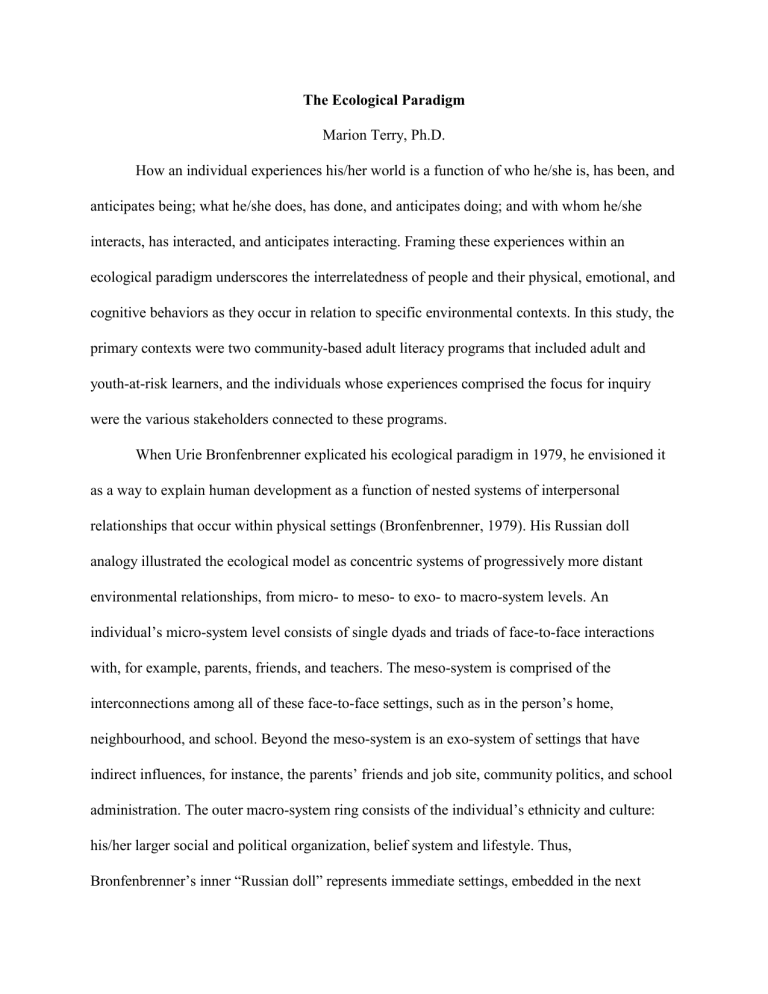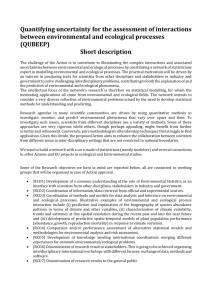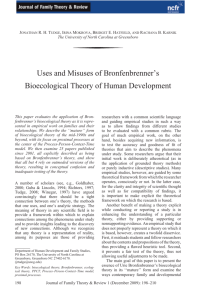The Ecological Paradigm

The Ecological Paradigm
Marion Terry, Ph.D.
How an individual experiences his/her world is a function of who he/she is, has been, and anticipates being; what he/she does, has done, and anticipates doing; and with whom he/she interacts, has interacted, and anticipates interacting. Framing these experiences within an ecological paradigm underscores the interrelatedness of people and their physical, emotional, and cognitive behaviors as they occur in relation to specific environmental contexts. In this study, the primary contexts were two community-based adult literacy programs that included adult and youth-at-risk learners, and the individuals whose experiences comprised the focus for inquiry were the various stakeholders connected to these programs.
When Urie Bronfenbrenner explicated his ecological paradigm in 1979, he envisioned it as a way to explain human development as a function of nested systems of interpersonal relationships that occur within physical settings (Bronfenbrenner, 1979). His Russian doll analogy illustrated the ecological model as concentric systems of progressively more distant environmental relationships, from micro- to meso- to exo- to macro-system levels. An individual’s micro-system level consists of single dyads and triads of face-to-face interactions with, for example, parents, friends, and teachers. The meso-system is comprised of the interconnections among all of these face-to-face settings, such as in the person’s home, neighbourhood, and school. Beyond the meso-system is an exo-system of settings that have indirect influences, for instance, the parents’ friends and job site, community politics, and school administration. The outer macro-system ring consists of the individual’s ethnicity and culture: his/her larger social and political organization, belief system and lifestyle. Thus,
Bronfenbrenner’s inner “Russian doll” represents immediate settings, embedded in the next
doll’s intersections of these immediate settings, embedded in the next doll’s indirect settings, embedded in the outer doll’s cultural setting. The stakeholders who participated in this research study were thus engaged in their own concentric systems of ecological relationships, as well as those relationships more or less proximal to the adult literacy program setting.
Central to the ecological paradigm is the notion of roles which, although grounded in the macro-system, are experienced most keenly in the micro-system (Bronfenbrenner, 1979). Roles dictate expectations for individual behaviours in interpersonal interactions (Clausen, 1995). They predict the degrees of superordination versus subordination, competition versus cooperation, and empowerment versus disempowerment, that characterize different relationships along the continua from micro-systems through meso-systems and exo-systems to macro-systems
(Bronfenbrenner, 1979). Roles define interpersonal settings and the transitions between settings
(Lerner, 1995). They thus outline the environmental forces that influence an individual’s realization of his/her potential (Ceci & Hembrooke, 1995). An important ecological focus for this study was therefore the roles that the participants assumed as stakeholders in their communitybased adult literacy programs, nested within their respective adult literacy programs’ micro-, meso-, exo-, and macro-system environments.
In 1988, Bronfenbrenner acknowledged that he had neglected in 1979 to spotlight the individual as the centre of his/her own ecological world, in a deliberate attempt to prioritize the impacts of physical and social environments on human development (Bronfenbrenner, 1988).
Subsequent adherents to Bronfenbrenner’s ecological model have shifted the microsystem outward so as to accommodate a central “ecological self” (Lee, 1993, p. 43) who intentionally interacts with his/her micro- and meso-systems and who is reflectively aware of the indirect relationships he/she has with exo- and macro-systems (Neisser, 1993). The ecological “me” is a
highly motivated interpersonal self (Jeannerod, 1993) who uses reciprocating communication
(Gibson, 1993) to interact with others on a wide range of physical, emotional, and intellectual levels (Buck, 1993). It is this interchange among internal and external systems that determines which environmental affordances will be perceived and activated (Gibson) in accordance with the role “expectations, evaluations, and obligations” (Neisser, p. 4) that define one’s conceptual self. The stakeholders in this research study must therefore be acknowledged as the nuclei of their individual ecological worlds, both responsive to and responsible for the environmental relationships that circumscribed the roles that they assumed – including those roles associated with the study’s adult literacy programs.
The ecological paradigm is an apt model for understanding stakeholder experiences with the community-based adult literacy programs in this study, because it celebrates the individuality of human understandings of self and others within nested systems of physical and interpersonal environmental contexts. Moreover, because it provides a framework for considering aspects of overlap and convergence among different individuals’ micro-, meso-, exo-, and macro-systems of experience, the ecological model also facilitated the cross-case comparisons that comprised an important part of this study’s analytical processes.
References
Bronfenbrenner, U. (1979). The ecology of human development: Experiments by nature and design . Cambridge, MA: Harvard University Press.
Bronfenbrenner, U. (1988). Foreword. In A. R. Pence (Ed.), Ecological research with children and families: From concepts to methodology (pp. ix-xix). New York: Teachers College
Press.
Buck, R. (1993). Spontaneous communication and the foundation of the interpersonal
self. In U. Neisser (Ed.), The perceived self: Ecological and interpersonal sources of selfknowledge (pp. 216-236). New York: Cambridge University Press.
Ceci, S. J., & Hembrooke, H. A. (1995). A bioecological model of intellectual development. In P. Moen, G. H. Elder, Jr., & K. Luscher (Eds.), Examining lives in context:
Perspectives on the ecology of human development (pp. 303-345). Washington, DC: American
Psychological Association.
Clausen, J. A. (1995). Gender, Contexts, and Turning Points in Adults’ Lives. In P.
Moen, G. H. Elder, Jr., & K. Luscher (Eds.), Examining lives in context: Perspectives on the ecology of human development (pp. 365-389). Washington, DC: American Psychological
Association.
Gibson, E. J. (1993). Ontogenesis of the perceived self. In U. Neisser (Ed.), The perceived self: Ecological and interpersonal sources of self-knowledge (pp. 25-42). New York:
Cambridge University Press.
Jeannerod, M. (1993). A theory of representation-driven actions. In U. Neisser (Ed.), The perceived self: Ecological and interpersonal sources of self-knowledge (pp. 68-88). New York:
Cambridge University Press.
Lee, D. L. (1993). Body-environment coupling. In U. Neisser (Ed.), The perceived self:
Ecological and interpersonal sources of self-knowledge (pp. 43-67). New York: Cambridge
University Press.
Lerner, R. M. (1995). Developing individuals within changing contexts: Implications of developmental contextualism for human development research, policy, and programs. In T. A.
Kindermann & J. Valsiner (Eds.), Development of person-context relations (pp. 13-37).
Hillsdale, NJ: Lawrence Erlbaum Associates.
Neisser, U. (Ed.). (1993). Introduction. The perceived self: Ecological and interpersonal sources of self-knowledge (pp. 3-21). New York: Cambridge University Press.










